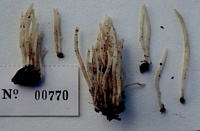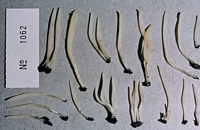|
 Clavaria subsordida Clavaria subsordida
BiostatusPresent in region - Indigenous. Endemic
Images (click to enlarge)
Caption: Microfiche 1-25. Clavaria subsordida. TENN no. 42382. | 
Caption: 1062, id. R. Petersen, label 50x10mm, NZ, NI, Waitakere R., Mill Bay, on soil among litter under
Leptospermum-Phyllocladus-Dacrydium, 06.07.1981, leg. EH
Owner: E. Horak |
Article: Petersen, R.H. (1988). The clavarioid fungi of New Zealand. New Zealand Department of Scientific and Industrial Research, Bulletin 236: 170 pp. Wellington:.
Description: Fruit bodies up to 40 x 3 mm, simple clubs occurring singly, scattered to gregarious,
narrowly fusiform to cylindrical, watery to subtranslucent. Club buff ("cream-buff") to dull
greenish yellow ("dark olive", "olive-buff" to paler than "pale olive-buff"), opaque,
appearing somewhat waxy, equal, not usually straight; apex rounded. Stipe obscurely silky,
but poorly delimited from hymenium, concolourous with club, paler ('"cartridge-buff") or
darker ("deep olive-buff"); inserted by very small, whitish mycelial patch. Taste and odour
negligible.
Macrochemical reaction: FCL = negative.
Tramal hyphae hardly inflated, clampless, thin-walled, hyaline, strictly parallel; secondary
septa occasional. Basidia 45-55 x 8-10 µm, clavate, multiguttulate when mature, bifurcate to
clamped; sterigmata 4, stout, divergent, more or less straight.
Spores 5.9-7 x 5.1-6.3 µm; globose to subglobose, thin-walled, smooth, uniguttulate when
mature; hilar appendix prominent, papillate.
Habitat: On bare soil under tree ferns and kauri.
Notes: Except for fruit body colour, the taxon resembles Clavaria acuta. Fruit bodies of the latter
taxon are white to off-white, but also often appear subtranslucent. As noted elsewhere
(Petersen 1984), however, microscopic characters, especially spores, are boringly repetitious
in parts of the subgenus, so the epithet acuta may shelter more than one taxon.
I am equally dubious about this taxon, for one collection had buff fruit bodies (TENN no.
42408), the others had pale greenish yellow fruit bodies (TENN no. 42382, 42428, s.n., etc).
In other respects they were identical.
In the field, the taxon is easily confused with Clavaria luteo-tenerrima Over which produces
fruit bodies of similar stature and colour. That taxon is placed in subg. Clavulinopsis, for
septa are universally clamped.
|